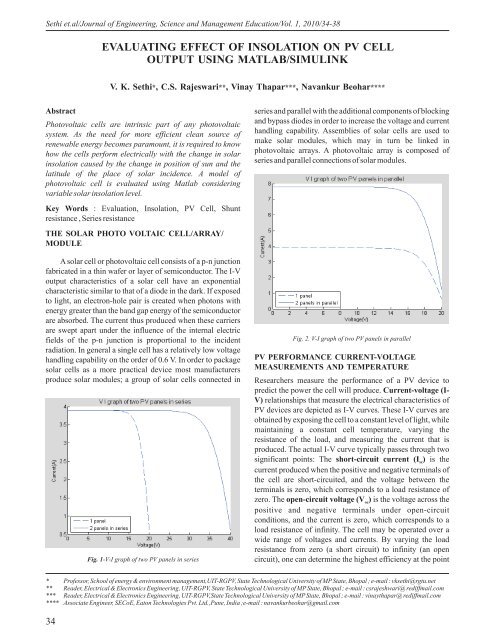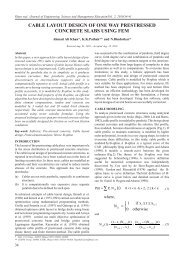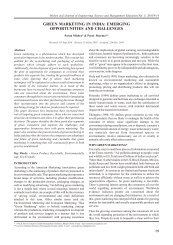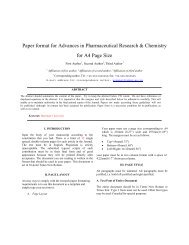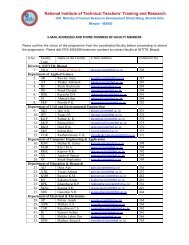evaluating effect of insolation on pv cell output using
evaluating effect of insolation on pv cell output using
evaluating effect of insolation on pv cell output using
Create successful ePaper yourself
Turn your PDF publications into a flip-book with our unique Google optimized e-Paper software.
Journal <str<strong>on</strong>g>of</str<strong>on</strong>g> Engineering, Science and Management Educati<strong>on</strong>The Zenith Angle (Z) is the angle from the observer's zenithpoint to the suns' positi<strong>on</strong> in the sky. In order to calculate thezenith angle latitude, solar declinati<strong>on</strong> angle and hour anglemust be c<strong>on</strong>sideredZenith Angle (Z)ZenithZSurface <str<strong>on</strong>g>of</str<strong>on</strong>g> the EarthFig. 6 Zenith Angle The solar c<strong>on</strong>stant is the average amount <str<strong>on</strong>g>of</str<strong>on</strong>g> energy striking<strong>on</strong>e square meter (perpendicular to the suns' rays) eachsec<strong>on</strong>d at the top <str<strong>on</strong>g>of</str<strong>on</strong>g> the earths' atmosphere. The satellite2measured solar c<strong>on</strong>stant is 1366 W/m . Of this energyreaching the top <str<strong>on</strong>g>of</str<strong>on</strong>g> the atmosphere as much as 70% can beabsorbed & reflected by the atmosphere. Solar <str<strong>on</strong>g>insolati<strong>on</strong></str<strong>on</strong>g>is the amount <str<strong>on</strong>g>of</str<strong>on</strong>g> energy received by the sun at the earths'2surface. On a clear day ~1000 W/m reaches a surfaceperpendicular to the incoming radiati<strong>on</strong>. This energyvaries due to the angle <str<strong>on</strong>g>of</str<strong>on</strong>g> the incoming radiati<strong>on</strong> and againcloud cover.Equati<strong>on</strong>s for Solar <str<strong>on</strong>g>insolati<strong>on</strong></str<strong>on</strong>g>S * cos ZSuns 1000whereZ cos 1 (sinsincoscoscos H )andH = 15O * (Time -12)Solar Declinati<strong>on</strong>Angles for the Northern HemisphereVernal Equinox Mar. 21/22Summer Solstice Jun. 21/22Autumnal Equinox Sept. 21/22Winter Solstice Dec. 21/22MAT LAB PROGRAM AND RESULTSun =0 O = +23.5 O =0 O = -23.5 OThe following MATLAB program calculates the I-Vcharacteristic <str<strong>on</strong>g>of</str<strong>on</strong>g> solar <strong>cell</strong> (with shunt resistance) taking<str<strong>on</strong>g>insolati<strong>on</strong></str<strong>on</strong>g> as a variable. This script calculates the <strong>output</strong>current corresp<strong>on</strong>ding to the required <strong>output</strong> voltage providedas the input. The <str<strong>on</strong>g>effect</str<strong>on</strong>g> <str<strong>on</strong>g>of</str<strong>on</strong>g> shunt resistance and the <str<strong>on</strong>g>effect</str<strong>on</strong>g> <str<strong>on</strong>g>of</str<strong>on</strong>g>variati<strong>on</strong> <str<strong>on</strong>g>of</str<strong>on</strong>g> solar <str<strong>on</strong>g>insolati<strong>on</strong></str<strong>on</strong>g> are also c<strong>on</strong>sidered. Solar<str<strong>on</strong>g>insolati<strong>on</strong></str<strong>on</strong>g> at a given place is calculated by taking intoc<strong>on</strong>siderati<strong>on</strong> the latitude <str<strong>on</strong>g>of</str<strong>on</strong>g> the place <str<strong>on</strong>g>of</str<strong>on</strong>g> incidence, time andday <str<strong>on</strong>g>of</str<strong>on</strong>g> the year. The <str<strong>on</strong>g>effect</str<strong>on</strong>g> <str<strong>on</strong>g>of</str<strong>on</strong>g> temperature variati<strong>on</strong> with thepassage <str<strong>on</strong>g>of</str<strong>on</strong>g> time <str<strong>on</strong>g>of</str<strong>on</strong>g> day is also taken into account.Although thevariati<strong>on</strong> <str<strong>on</strong>g>of</str<strong>on</strong>g> temperature as well as solar declinati<strong>on</strong> angle isassumed to be linear. The result is calculated for latitude =Oth23.2667 , for 15 <str<strong>on</strong>g>of</str<strong>on</strong>g> May functi<strong>on</strong> I = panelvarshunt(V,TeC)%PANELVARSHUNT - File to calculate <strong>output</strong> currentcorresp<strong>on</strong>ding% to required <strong>output</strong> voltage given as input.%Call syntax: I = panelvarshunt(V,TeC);%Input: V = <strong>output</strong> voltage required (may be a vector),% TeC = surrounding temperature in degree Celsius% (may be a vector)% latitude,time in 24 hr format (may be avector),date,m<strong>on</strong>th.%Output: I = <strong>output</strong> current corresp<strong>on</strong>ding to voltage V%-------------------------------------%% C<strong>on</strong>stantsk = 1.38e-23; % Boltzman's c<strong>on</strong>stq = 1.60e-19; % charge <strong>on</strong> an electr<strong>on</strong>n = 1.2; % diode quality factorVg = 1.1; % band gap voltage, 1.1eV for Si.Ns = 36; % No. <str<strong>on</strong>g>of</str<strong>on</strong>g> <strong>cell</strong>s in a arrayRs = 0.008; % series resistance <str<strong>on</strong>g>of</str<strong>on</strong>g> <strong>cell</strong>(in ohms)Rsh = 200; % shunt resistance <str<strong>on</strong>g>of</str<strong>on</strong>g> <strong>cell</strong>(in ohms)S = 1000; % solar <str<strong>on</strong>g>insolati<strong>on</strong></str<strong>on</strong>g> <strong>on</strong> a clear sunny dayd2r = pi/180; % c<strong>on</strong>verts degree to radians%% Inputslatitude = 23.2667;time = linspace(6,18,50);date = 15;m<strong>on</strong>th = 5;%% Calculati<strong>on</strong> <str<strong>on</strong>g>of</str<strong>on</strong>g> sunsswitch (m<strong>on</strong>th)case {1}dateeq = 12 + date;case {2}dateeq = 12 + 31 + date;case {3}dateeq = 12 + 31 + 28 + date;case {4}dateeq = 12 + 31 + 28 + 31 + date;case {5}dateeq = 12 + 31 + 28 + 31 + 30 + date;case {6}if(date
Journal <str<strong>on</strong>g>of</str<strong>on</strong>g> Engineering, Science and Management Educati<strong>on</strong>case {10}dateeq = 11 + 31 + 31 + 30 + date;case {11}dateeq = 11 + 31 + 31 + 30 + 31 + date;case {12}if(date = 6 && date >= 21) && (m<strong>on</strong>th
Journal <str<strong>on</strong>g>of</str<strong>on</strong>g> Engineering, Science and Management Educati<strong>on</strong>4. H. Suehrcke, C. P. Ling and P. G. McCormick,“Thedynamic resp<strong>on</strong>se <str<strong>on</strong>g>of</str<strong>on</strong>g> instruments measuringinstantaneous solar radiati<strong>on</strong>.” Solar Energy, Vol. 44, pp.145-148, 1990.5. J. A. Gow, C. D. Manning “Development <str<strong>on</strong>g>of</str<strong>on</strong>g> aphotovoltaic array model for use in powerelectr<strong>on</strong>icssimulati<strong>on</strong> studies,” IEE Proceedings<strong>on</strong> Electric PowerApplicati<strong>on</strong>s, vol. 146, no. 2,pp. 193-00,March 1999.6. J.D. Balcomb and S.J. Hayter and N.L. Weaver, “HourlySimulati<strong>on</strong> <str<strong>on</strong>g>of</str<strong>on</strong>g> Grid-C<strong>on</strong>nected PV Systems UsingRealistic Building Loads”, American Solar EnergySociety (ASES) Nati<strong>on</strong>al Solar C<strong>on</strong>ferences Forum,2001.7. M. A. Green, Solar Cells,University <str<strong>on</strong>g>of</str<strong>on</strong>g> New SouthWales, 1992.8. Omid Sheko<str<strong>on</strong>g>of</str<strong>on</strong>g>a', Mohsen Taherbaneh, “Modelling <str<strong>on</strong>g>of</str<strong>on</strong>g>Silic<strong>on</strong> Solar Panel by MATLAB/Simulink andEvaluating the Importance <str<strong>on</strong>g>of</str<strong>on</strong>g> Its Parameters in a SpaceApplicati<strong>on</strong>”, Amirkabir University <str<strong>on</strong>g>of</str<strong>on</strong>g> Technology,Tehran 20069. Poul Sorensen, Anca D. Hansen, Lars S. Hansen andHenrik Bindner,”Models for a Stand-Al<strong>on</strong>e PVSystem”, ,Riso Nati<strong>on</strong>al Laboratory, Roskolde 2000.10. Sedra Adel S. and Smith Kenneth C. "Microelectr<strong>on</strong>icCircuits",Fifth Editi<strong>on</strong>, Oxford University Press, 2007.38


